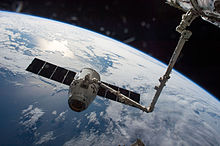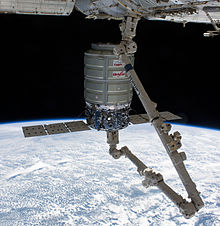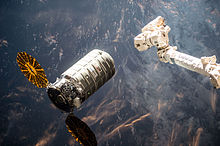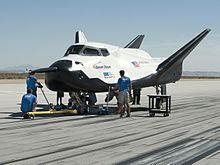Commercial Resupply Services

In March 2013, a SpaceX Dragon is berthed to the ISS

Cygnus 5 near ISS, 2015
Commercial Resupply Services (CRS[1]) are a series of contracts awarded by NASA from 2008–2016 for delivery of cargo and supplies to the International Space Station (ISS) on commercially operated spacecraft. The first CRS contracts were signed in 2008 and awarded $1.6 billion to SpaceX for 12 cargo transport missions and $1.9 billion to Orbital Sciences for 8 missions, covering deliveries to 2016. In 2015, NASA extended the Phase 1 contracts by ordering an additional three resupply flights from SpaceX and one from Orbital Sciences.[2] After additional extensions late in 2015, SpaceX is currently scheduled to have a total of 20 missions and Orbital 10.[3]
SpaceX began flying resupply missions in 2012, using Dragon cargo spacecraft launched on Falcon 9 rockets from Space Launch Complex 40 at Cape Canaveral Air Force Station, Cape Canaveral, Florida.[4] Orbital Sciences began deliveries in 2013 using Cygnus spacecraft launched on the Antares rocket from Launch Pad 0A at the Mid-Atlantic Regional Spaceport (MARS), Wallops Island, Virginia.[5]
A second phase of contracts (known as CRS2) were solicited and proposed in 2014. They were awarded in January 2016 to Orbital ATK, Sierra Nevada Corporation, and SpaceX, for cargo transport flights beginning in 2019 and expected to last through 2024.
Contents
1 History
2 Phase 1 Missions
2.1 SpaceX
2.2 Orbital Sciences
3 Commercial Resupply Services 2
3.1 Solicitation and proposal period
3.2 Contracts awarded
4 See also
5 References
6 External links
History
@media all and (max-width:720px).mw-parser-output .tmulti>.thumbinnerwidth:100%!important;max-width:none!important.mw-parser-output .tmulti .tsinglefloat:none!important;max-width:none!important;width:100%!important;text-align:center



ISS crew inside Dragon C2, docked to ISS in 2012
US public laws dating back to 1984 and 1990 have directed NASA to pursue commercial options for launching spaceflight missions, whenever such commercial offerings are available. By the 2000s, other more specific Congressional authorizations began to fund explicit development of commercial options for NASA, first for cargo services, and later for ISS crew transport services as well.
The selection of the firms resupplying the space station was publicly discussed by NASA on December 22, 2008. NASA announced the awarding of contracts for 12 flights by SpaceX and 8 flights by Orbital Sciences Corporation in a press conference on December 23, 2008.[6]PlanetSpace submitted a protest to the Government Accountability Office after receiving a NASA briefing on the outcome of the award.[7] On April 22, 2009 GAO publicly released its decision to deny the protest.[8]
The launch vehicles and cargo carriers were developed using Space Act Agreements under NASA's Commercial Orbital Transportation Services (COTS) program.[9]
SpaceX launched their first Falcon 9 rocket and a mock-up Dragon capsule successfully on June 4, 2010. Their first flight contracted by NASA, COTS Demo Flight 1, took place on December 8, 2010, demonstrating the Dragon capsule's multiple orbit capability, ability to receive and respond to ground commands, and ability to gain and maintain directional alignment with NASA's Tracking and Data Relay Satellite System narrow-band satellite communication system. On August 15, 2011, SpaceX announced NASA had combined the mission objectives of the COTS Demo Flight 2 and 3 missions into a single mission, with the COTS 3 validation tests beginning only if all of the COTS 2 objectives were successfully demonstrated first.[10][11]
The COTS Demo Flight 2+ mission successfully launched on May 22, 2012, delivered cargo to the ISS and on May 31, landed in the Pacific and was recovered.[12] On August 23, 2012, NASA announced that SpaceX had successfully completed its COTS Space Act Agreement and NASA certified SpaceX to begin their CRS contracted spaceflights.[13] SpaceX began their first CRS flight in October 2012.
Orbital Sciences completed their COTS certification with a flight on September 29, 2013 and their first CRS mission was launched January 9, 2014. In February 2016, five additional missions were added to the CRS contract for an estimated $700 million.[14]
NASA began a formal process to initiate Phase 2 of the Commercial Resupply Services, CRS2, in early 2014. Three companies were awarded contracts on January 14, 2016.[15]
The docking of SpaceX CRS-8 at the ISS on April 10, 2016, while Cygnus CRS OA-6 was also docked, marked the first time a Dragon spacecraft and a Cygnus spacecraft were docked with the ISS at the same time. At the time, Dragon was docked at Harmony nadir, while Cygnus was docked at Unity nadir.
Phase 1 Missions
 Play media
Play mediaU.S. Commercial Cargo Ship Departs Space Station
Transport flights began under phase 1 of the Commercial Resupply Services contract, CRS 1, in 2012 and are planned to continue until the CRS 2 contracts commence in 2019.
SpaceX

SpaceX Dragon spacecraft being integrated with Falcon 9 launch rocket, 2012

CRS-8 Dragon at ISS, 2016
The first CRS mission, SpaceX CRS-1, was scheduled for October 8, 2012 at 00:35 UTC from Cape Canaveral Air Force Station Space Launch Complex 40 in Florida.[4] It was the first of 12 planned resupply missions. CRS-1 took off on October 8, 2012 at 03:03:52 AM GMT, achieved orbit, berthing and remained on station until October 28, 2012. Dragon then re-entered the earth's atmosphere and successfully splashed down in the Pacific Ocean.[16]
SpaceX CRS-2, the second CRS mission from SpaceX, was successfully launched on March 1, 2013.[17]
SpaceX CRS-3, SpaceX's third CRS mission, was scheduled for launch on March 30, 2014,[18] but was delayed due to a fire at one of the radar facilities on the Eastern Range. The launch completed successfully on April 18.
SpaceX CRS-4, SpaceX's fourth CRS mission, was scheduled for launch on September 20, 2014, but was delayed due to adverse weather conditions; the launch occurred on Sunday, September 21, 2014 at 1:52 a.m. EDT (0552 GMT) from Cape Canaveral Air Force Station in Florida.[19] The capsule was subsequently reused in CRS-11 mission on June 3, 2017.[20]
SpaceX CRS-5, SpaceX's fifth CRS mission, was scheduled for launch on December 9, 2014, but was delayed over several dates in December due to manifest adjustments for items lost from the Cygnus CRS Orb-3 launch failure, technical issues found from a static fire test, the U.S. holiday season and staff scheduling, as well as a beta angle period during late December where thermal and operational constraints would make a Dragon berthing prohibited. The launch was rescheduled for January 6, 2015. At 1 minute 27 seconds to launch, the launch was scrubbed due to a thrust vector actuator problem with the second stage engine. The launch was rescheduled to Saturday, January 10, 2015, which completed successfully at 4:47 AM Central time.[21]
SpaceX CRS-6, SpaceX's sixth CRS mission, was successfully launched on April 14, 2015, at 20:10:41 UTC from Cape Canaveral Air Force Station in Florida.
SpaceX CRS-7, SpaceX's seventh CRS mission, was attempted on June 28, 2015 from Cape Canaveral Air Force Station in Florida. The mission suffered a catastrophic failure, with an anomaly occurring during the ascent of the first stage, resulting in an explosion and a total loss of the vehicle.
SpaceX CRS-8, SpaceX's eighth CRS mission, was successfully launched on April 8, 2016 from Cape Canaveral Air Force Station in Florida. The first stage landed successfully on SpaceX's drone ship in the Atlantic Ocean, and was subsequently reused to launch SES-10 on March 30, 2017.
SpaceX CRS-9, SpaceX's ninth CRS mission, was successfully launched on July 18, 2016 from Cape Canaveral Air Force Station in Florida. The first stage landed successfully at Landing Zone 1.
SpaceX CRS-10, SpaceX's tenth CRS mission, was aborted on February 18, 2017 due to an anomaly in the Thrust Vector Control (TVC) of the second stage but successfully launched on the February 19 from Kennedy Space Center in Florida. The first stage landed successfully on Landing Zone 1.
SpaceX CRS-11, SpaceX's 11th CRS mission, was successfully launched on June 3, 2017 from Kennedy Space Center LC-39A, being the 100th mission to be launched from that pad. Launch attempt on June 1 was aborted due to bad weather. This mission was the first to re-fly a recovered Dragon capsule that previously flew on CRS-4 mission. This mission delivered 2,708 kilograms[20] of cargo to the International Space Station, including NICER.[22] The first stage of the Falcon 9 launch vehicle landed successfully at Landing Zone 1.
SpaceX CRS-12, SpaceX's 12th CRS mission, was successfully launched on the first 'Block 4' version of the Falcon 9 on August 14, 2017 from Kennedy Space Center LC-39A at the first attempt. This mission delivered 2,349 kg (5,179 lb) of pressurized mass and 961 kg (2,119 lb) unpressurized. The external payload manifested for this flight was the CREAM cosmic-ray detector. Last flight of a newly-built Dragon capsule; further missions will use refurbished spacecraft.[23]
SpaceX CRS-13, SpaceX's 13th CRS mission, was successfully launched on December 15, 2017.[24]
SpaceX CRS-14, launched at 16:30 EDT (20:30 UTC) on April 2, 2018 and berthed at the ISS on April 4, 2018
SpaceX CRS-15, launched at 05:42 EDT (09:42 UTC) on June 29, 2018 and berthed at the ISS on July 2, 2018.[25]
SpaceX CRS-16, was successfully launched on December 5, 2018 at 13:16 EDT (18:16 UTC) and berthed at the ISS on December 8, 2018[26], marking the success of SpaceX's primary mission. [27] However, their secondary mission of landing the Falcon 9 booster was unsuccessful. [28]
Orbital Sciences

Standard size Cygnus spacecraft

Enhanced size Cygnus spacecraft

Cygnus approaching ISS to support Expedition 47
Orbital Sciences rolled out its Antares rocket to the launchpad at the Mid-Atlantic Regional Spaceport in October 2012 in preparation for an on-pad hot-fire test of the rocket in early November 2012. The rocket successfully made its initial launch with a test payload on April 21, 2013.[29]
Orbital Sciences' first COTS demonstration mission was successfully carried out on September 29, 2013, a week behind schedule due to a software malfunction;[30] this is a predecessor mission to the start of Orbital Commercial Resupply Services missions contracted by NASA to resupply the International Space Station.[31][32]CRS-1 and CRS-2 followed on.
Orbital Sciences' 3rd Resupply mission (CRS-3) from NASA's Wallops Flight Facility on October 28, 2014 failed. First Antares launch to use Castor 30XL upperstage, delayed due to boat in launch safe zone. Second takeoff attempt suffered a catastrophic anomaly resulting in an explosion shortly after launch. Contents of the cargo included: Food and care packages for the crew, parts, experiments, and the Arkyd-3 Flight Test (Non-optical) Satellite from Planetary Resources. Shortly after lift-off from the Mid-Atlantic Regional Spaceport Pad 0A at 6:22 p.m. (EDT), the vehicle suffered a catastrophic failure. According to NASA's emergency operations officials, there were no casualties and property damage was limited to the south end of Wallops Island. The company decided to discontinue the Antares 100 series and accelerate the introduction of a new propulsion. The Antares 230 system was upgraded with newly built RD-181 first-stage engines to provide greater payload performance and increased reliability.[33]
In the meantime, the company had contracted with United Launch Alliance for an Atlas V launch of OA-4 in late 2015 from Cape Canaveral, FL which flew on December 6, 2015. That mission also marked the debut of the bigger Enhanced Cygnus, intended for use on all following CRS contracted missions.[34] The company planned Cygnus missions for the first (OA-5), second (OA-6) and fourth quarters (OA-7) of 2016. CRS OA-6 was successfully launched on March 23, 2016 by the Atlas V. CRS OA-5 and CRS OA-7, launched on the new Antares 230, on October 17, 2016 and April 18, 2017 respectively. The switch to the more powerful Atlas V and Antares 230, along with Enhanced Cygnus increased volume, enabled Orbital ATK to cover their initial CRS contracted payload obligation by OA-7.[34][35]
During August 2015, Orbital ATK disclosed that they had received an extension of the resupply program for three extra missions. These additional missions enables NASA to cover the ISS resupply needs until the Commercial Resupply Services 2 contract enters in effect. The OA-8E flight was tentatively scheduled for June 12, 2017[34] and flew on November 12, 2017.
OA-9E was successfully launched on May 20, 2018. [36][37]
Cygnus NG-10 (formally called OA-10E) was successfully launched on November 17, 2018. [38]
Commercial Resupply Services 2
The Commercial Resupply Services 2 (CRS2) contract definition/solicitation period commenced in 2014[39] and a result announced on January 14, 2016. The CRS2 launches are expected to commence in 2019, and extend to at least 2024.
Solicitation and proposal period
On February 21, 2014 NASA posted Request For Information (RFI) NNJ14ZBG007L about a possible follow on to the current Commercial Resupply Services (CRS1) to the International Space Station (ISS).[40]
An "Industry Day" set of meetings was held in Houston on April 10, 2014, where seven high-level requirements for the second Cargo Resupply Services contract solicitation were disclosed to parties who may be interested in contracting with the government to supply "nonscheduled chartered freight air transportation" resupply services to the ISS in the 2015–2024 time period.[39]
The contracts were expected to include "delivery of pressurized and unpressurized cargo, return and disposal of pressurized cargo, disposal of unpressurized cargo, and ground support services for the end-to-end resupply mission":[39]
- delivery of approximately 14,000 to 17,000 kg (31,000 to 37,000 lb) per year 55 to 70 m3 (1,900 to 2,500 cu ft) of pressurized cargo in four or five transport trips
- delivery of 24–30 powered lockers per year, requiring continuous power of up to 120 watts at 28 volts, with cooling and two-way communication services
- delivery of approximately 1,500 to 4,000 kg (3,300 to 8,800 lb) per year of unpressurized cargo, consisting of 3 to 8 items, each item requiring continuous power of up to 250 watts at 28 volts, with cooling and two-way communication services
return/disposal of approximately 14,000 to 17,000 kg (31,000 to 37,000 lb) per year 55 to 70 m3 (1,900 to 2,500 cu ft) of pressurized cargo- disposal of 1,500 to 4,000 kg (3,300 to 8,800 lb) per year of unpressurized cargo, consisting of 3 to 8 items
- various ground support services for the end-to-end ISS resupply mission
NASA planned to release the draft request for proposal (RFP) in May 2014 with a final RFP in June 2014.[39] Proposals were due in July 2014, and at least two contracts were expected to be awarded.
Five companies were known to have submitted proposals to NASA: SpaceX, Orbital ATK, Boeing, Sierra Nevada (SNC), and Lockheed Martin. Although the contract awards were originally anticipated by NASA in April 2015, they moved back to a June target date, and in April, delayed again to a contract award target date of September 2015[41] and the selection for the contract was not made until January 14, 2016.
CRS1 contractors Orbital Sciences and SpaceX each submitted CRS2 proposals.[42] In addition, Boeing, Lockheed Martin, and SNC submitted proposals for CRS2. SNC's proposal would use a cargo version of its Dream Chaser crew vehicle, the Dream Chaser Cargo System, while Boeing's proposal would likewise use a cargo version of its CST-100 crew vehicle.[43][44] The proposed cargo Dream Chaser included an additional expendable cargo module for uplift and trash disposal. Downmass would only be provided via the Dream Chaser spaceplane itself.[42]
Lockheed Martin proposed a cargo transport system called Jupiter, a spacecraft that was to be derived from designs of the Mars Atmosphere and Volatile Evolution Mission and the Juno spacecraft. It would include a robotic arm, from MDA based on Shuttle Arm technology. The Lockheed proposal included a new 4.4-meter (14 ft) diameter cargo transport module called Exoliner, based on the ESA Automated Transfer Vehicle, to be jointly developed with Thales Alenia Space.[44][45][46]
Contracts awarded

Sierra Nevada Dream Chaser in development, 2013 drop-test preparations shown
On January 14, 2016, NASA announced that three companies had been awarded contracts for a minimum of six launches each: SpaceX, Orbital ATK and SNC.[15][47] The maximum potential value of all the contracts was indicated to be $14 billion but the minimum requirements would be considerably less. No further financial information was disclosed. The missions involved would be from late 2019 through to 2024.
See also
- Cargo spacecraft
Commercial Crew Development (CCDev) – development of crew vehicles- Commercial Orbital Transportation Services
- Comparison of space station cargo vehicles
- Lockheed Martin X-33
Multi-Purpose Logistics Module (STS cargo container)
References
^ Jason Rhian (September 27, 2014). "NASA continues Commercial "push" with CRS extension". Spaceflight Insider..mw-parser-output cite.citationfont-style:inherit.mw-parser-output .citation qquotes:"""""""'""'".mw-parser-output .citation .cs1-lock-free abackground:url("//upload.wikimedia.org/wikipedia/commons/thumb/6/65/Lock-green.svg/9px-Lock-green.svg.png")no-repeat;background-position:right .1em center.mw-parser-output .citation .cs1-lock-limited a,.mw-parser-output .citation .cs1-lock-registration abackground:url("//upload.wikimedia.org/wikipedia/commons/thumb/d/d6/Lock-gray-alt-2.svg/9px-Lock-gray-alt-2.svg.png")no-repeat;background-position:right .1em center.mw-parser-output .citation .cs1-lock-subscription abackground:url("//upload.wikimedia.org/wikipedia/commons/thumb/a/aa/Lock-red-alt-2.svg/9px-Lock-red-alt-2.svg.png")no-repeat;background-position:right .1em center.mw-parser-output .cs1-subscription,.mw-parser-output .cs1-registrationcolor:#555.mw-parser-output .cs1-subscription span,.mw-parser-output .cs1-registration spanborder-bottom:1px dotted;cursor:help.mw-parser-output .cs1-ws-icon abackground:url("//upload.wikimedia.org/wikipedia/commons/thumb/4/4c/Wikisource-logo.svg/12px-Wikisource-logo.svg.png")no-repeat;background-position:right .1em center.mw-parser-output code.cs1-codecolor:inherit;background:inherit;border:inherit;padding:inherit.mw-parser-output .cs1-hidden-errordisplay:none;font-size:100%.mw-parser-output .cs1-visible-errorfont-size:100%.mw-parser-output .cs1-maintdisplay:none;color:#33aa33;margin-left:0.3em.mw-parser-output .cs1-subscription,.mw-parser-output .cs1-registration,.mw-parser-output .cs1-formatfont-size:95%.mw-parser-output .cs1-kern-left,.mw-parser-output .cs1-kern-wl-leftpadding-left:0.2em.mw-parser-output .cs1-kern-right,.mw-parser-output .cs1-kern-wl-rightpadding-right:0.2em
^ Bergin, Chris. "NASA lines up four additional CRS missions for Dragon and Cygnus". nasaspaceflight.com. Retrieved April 19, 2015.
^ de Selding, Peter B. "SpaceX wins 5 new space station cargo missions in NASA contract estimated at $700 million". SpaceNews. Retrieved July 17, 2016.
^ ab "SpaceX, NASA Target Oct. 7 Launch For Resupply Mission To Space Station". NASA. September 20, 2012. Retrieved September 26, 2012.
^ "Cygnus heads for the International Space Station". gizmag.com. September 18, 2013. Retrieved October 1, 2013.
^ "NASA Awards Space Station Commercial Resupply Services Contracts". NASA, December 23, 2008.
^ Chris Bergin (January 15, 2009). "Planetspace officially protest NASA's CRS selection".
^ "B-401016; B-401016.2, PlanetSpace, Inc., April 22, 2009". GAO. April 22, 2009.
^ "NASA Commercial Orbital Transportation Services". NASA. Retrieved October 15, 2012.
^ "SpaceX 2011 Update Page". SpaceX. December 15, 2011. Retrieved December 3, 2011.
^ "SpaceX plans November test flight to space station". AFP. August 15, 2011. Retrieved December 3, 2011.
^ Clark, Stephen (June 2, 2012). "NASA expects quick start to SpaceX cargo contract". SpaceFlightNow. Retrieved June 23, 2012.
^ "NASA Administrator Announces New Commercial Crew And Cargo Milestones". NASA. August 23, 2012. Retrieved August 23, 2012.
^ "SpaceX wins 5 new space station cargo missions in NASA contract estimated at $700 million - SpaceNews.com". February 24, 2016.
^ ab "Sierra Nevada Corp. joins SpaceX and Orbital ATK in winning NASA resupply contracts". Washington Post. Jan 14, 2016. Retrieved January 17, 2016.
^ "NASA Celebrates Dragon's Return".
^ "Worldwide Launch Schedule". Spaceflight Now. Retrieved May 28, 2012.
^ "Worldwide Launch Schedule". Spaceflight Now. Retrieved October 30, 2013.
^ "Worldwide launch schedule". Spaceflightnow. November 22, 2012. Retrieved July 8, 2014.
^ ab Clark, Stephen. "Cargo manifest for SpaceX's 11th resupply mission to the space station – Spaceflight Now". Retrieved June 3, 2017.
^ "CRS-5 Dragon successfully launched – Core ASDS landing attempted". NASASpaceFlight. January 10, 2015. Retrieved January 15, 2015.
^ "The Neutron star Interior Composition ExploreR Mission". NASA. Retrieved February 26, 2016.Previously scheduled for a December 2016 launch on SpaceX-12, NICER will now fly to the International Space Station with two other payloads on SpaceX Commercial Resupply Services (CRS)-11, in the Dragon vehicle's unpressurized Trunk.
^ TDRS-M given priority over CRS-12 Dragon as launch dates realign Nasa Spaceflight.com July 26, 2017
^ "SpaceX launches and lands its first used rocket for NASA". The Verge. Retrieved December 15, 2017.
^ Gebhardt, Chris (July 2, 2018). "SpaceX CRS-15 Dragon arrives at ISS with science/crew supply payloads". NASASpaceFlight.com. Retrieved August 9, 2018.
^ "Dragon Attached to Station, Returns to Earth in January – Space Station". blogs.nasa.gov. Retrieved December 8, 2018.
^ "Falcon 9 successfully lofts CRS-16 Dragon enroute to ISS – Booster spins out but soft lands in water – NASASpaceFlight.com". Retrieved December 6, 2018.
^ Grush, Loren (December 5, 2018). "For the first time ever, a SpaceX Falcon 9 rocket fails to stick a ground landing". The Verge. Retrieved December 6, 2018.
^ Perrotto, Trent J. (April 21, 2013). "NASA Partner Orbital Sciences Test Launches Antares Rocket" (Press release). NASA. Retrieved April 25, 2013.
^ "Cygnus docks with International Space Station". gizmag.com. September 29, 2013. Retrieved October 1, 2013.
^ "Antares home page". Orbital Sciences. October 2012. Retrieved October 13, 2012.
^ "Antares press release". Orbital Sciences. October 2012. Retrieved October 13, 2012.
^ Chris (August 14, 2015). "Orbital ATK make progress toward Return To Flight of Antares rocket". NASASpaceflight.com. Retrieved August 14, 2015.
^ abc Leone, Dan (August 17, 2015). "NASA Orders Two More ISS Cargo Missions From Orbital ATK". SpaceNews.com. Retrieved August 17, 2015.
^ Leone, Dan (August 20, 2015). "NASA Considering More Cargo Orders from Orbital ATK, SpaceX". SpaceNews.com. Retrieved August 20, 2015.
^ "Antares • Cygnus OA-9". Retrieved December 8, 2018.
^ "Cygnus OA-9E delivers the science, won't be used as experiment module this flight – NASASpaceFlight.com". Retrieved December 8, 2018.
^ Clark, Stephen. "Live coverage: Commercial Cygnus cargo craft arrives at space station – Spaceflight Now". Retrieved December 8, 2018.
^ abcd
"International Space Station Commercial Resupply Services 2 Industry Day". ppt file. NASA. April 10, 2014. Retrieved April 12, 2014.
^ "COMMERCIAL RESUPPLY SERVICES 2 – RFI NNJ14ZBG007L". NASA. February 21, 2014. Retrieved February 24, 2014.
^
Foust, Jeff (April 21, 2015). "NASA Delays Award of Commercial Cargo Follow-On Contracts". Space News. Retrieved April 22, 2015.
^ ab Jeff Foust (March 17, 2015). "Sierra Nevada Hopes Dream Chaser Finds "Sweet Spot" of ISS Cargo Competition". Space News.
^ Dan Leone (January 24, 2015). "Weather Sat, CRS-2 Top U.S. Civil Space Procurement Agenda for 2015". SpaceNews.com.
^ ab Jeff Foust (March 13, 2015). "Lockheed Martin Pitches Reusable Tug for Space Station Resupply". Space News.
^
Avery, Greg (March 12, 2015). "Lockheed Martin proposes building ISS cargo ship for NASA". Denver Business Journal. Retrieved March 13, 2015.
^ ‘Jupiter’ Space Tug Could Deliver Cargo To The Moon, March 12, 2015, retrieved March 13, 2015.
^ "NASA Awards International Space Station Cargo Transport Contracts" (Press release). NASA. January 14, 2016. Retrieved August 24, 2017.
External links
- NASA Commercial Crew and Cargo webpage
- SpaceX (Space Exploration Technologies Corporation)
- OSC (Orbital Sciences Corporation)
- CRS contracts and Space Act agreements
